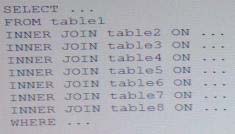Oracle 1z0-882 Exam Practice Questions (P. 5)
- Full Access (100 questions)
- Six months of Premium Access
- Access to one million comments
- Seamless ChatGPT Integration
- Ability to download PDF files
- Anki Flashcard files for revision
- No Captcha & No AdSense
- Advanced Exam Configuration
Question #21
A table (t1) contains 1000 random integer values in the first column (col1).The random values are in the range of 0-1000.
Examine this query:
SELECT col1 FROM t1 WHERE col1 <=100 UNION
SELECT col1 FROM t1 WHERE col1 >=900 ORDER BY col1 DESC
What is the expected output?
Examine this query:
SELECT col1 FROM t1 WHERE col1 <=100 UNION
SELECT col1 FROM t1 WHERE col1 >=900 ORDER BY col1 DESC
What is the expected output?
- AA list of all values, including duplicates, sorted in descending order in the ranges of 0-100 and 900-1000
- BA list of all random unsorted values, including duplicates, in the range of 0-100 followed by the list of all values, including in the range of 900-1000 sorted in descending order
- CA list of unique random values in the range of 0-100 followed by the list of unique values in the range of 900-1000 sorted in descending order
- DA list of all unique values sorted in descending order within the ranges of 0-100 and 900-1000
Correct Answer:
B
B
send
light_mode
delete
Question #22
A SELECT statement without an ORDER BY clause return some rows.
Which statement is always true about the order of the returned results?
Which statement is always true about the order of the returned results?
- AThe results are in ascending order.
- BThe results are in descending order.
- CThe results are in the order inserted.
- DThe results are not in a set order.
Correct Answer:
C
Reference: http://www.postgresql.org/docs/8.2/static/sql-select.html#SQL-ORDERBY
C
Reference: http://www.postgresql.org/docs/8.2/static/sql-select.html#SQL-ORDERBY
send
light_mode
delete
Question #23
A complex query consists of eight populated tables that are all connected via INNER JOIN operands as shown:

You modify the query and replace the SELECT operand with SELECT STRAIGHT JOIN.
What is the effect of adding STRAIGHT JOINs to the query?

You modify the query and replace the SELECT operand with SELECT STRAIGHT JOIN.
What is the effect of adding STRAIGHT JOINs to the query?
- AThe optimizer processes only the JOINs in the sequence listed in the query.
- BThe optimizer will only JOIN the tables by using their PRIMARY KEYS or UNIQUE constraints.
- CThe optimizer will only JOIN the tables in sequence from smallest to largest.
- DThe optimizer ignores all terms in the WHERE clause until all JOINs have been completed.
Correct Answer:
A
A
send
light_mode
delete
Question #24
Which two can be used to obtain information stored in the Diagnostics Area?
- ASHOW WARNINGS
- BGET DIAGNOSTICS CONDITION 1 @errno=MYSQL_ERRNO, @msg =MESSAGE_TEXT; SELECT @errno, @msg;
- CSELECT ERRNO, MESSAGE_TEXT FROM INFORMATION_SCHEMA.DIAGNOSTICS_AREA WHERE CONDITION=1
- DSHOW GLOBAL STATUS LIKE ‘Diagnostics’
Correct Answer:
AB
Reference:
http://dev.mysql.com/doc/refman/5.6/en/diagnostics-area.html
AB
Reference:
http://dev.mysql.com/doc/refman/5.6/en/diagnostics-area.html
send
light_mode
delete
Question #25
Which there statements describe valid reasons why queries that use "SELECT" construct are discouraged?
- ASELECT * may cause more data than you need to be read from disk if your application needs only some columns.
- BSELECT * causes more data than you need to be sent via the client/server protocol if your application needs only some columns.
- CSELECT * prevents the use of indexes, so a full table scan for every query.
- DSELECT *causes your application to depend on the columns present when you wrote it , so your application could break if the table structure changes.
- ESELECT * causes the statements to return all rows from the table.
Correct Answer:
ABD
ABD
send
light_mode
delete
All Pages
